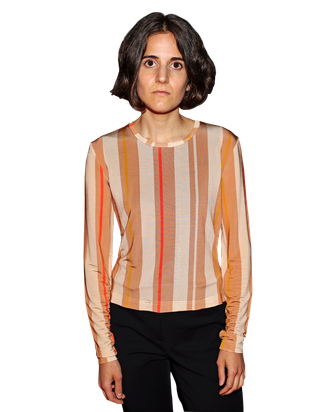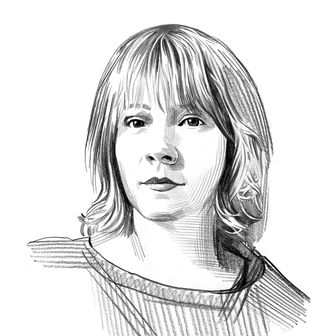
A cursed mirror. The ghost of Marilyn Monroe. An owl in a wig. Images such as these are scattered throughout Los Espookys, the new HBO show from Fred Armisen, Julio Torres, and Ana Fabrega. Los Espookys is perhaps the weirdest work-com ever. Four friends begin a bespoke horror-experience business, creating moments of terror and eeriness for their clients. Fabrega, who co-wrote the show and plays the spacey Tati, says the Spanish-language comedy is a perfect overlap of her and Torres’s comedic sensibilities.
Fabrega has been creating little moments of surreal mundanity on The Chris Gethard Show and her social-media platforms for years. She uses Instagram to create products no one needs and makes videos of the worst way to find someone in a crowd. Fabrega talked to Vulture about the collaborative atmosphere of Los Espookys, finding your purpose in life through work, and how to audition fake teeth.
How did Los Espookys come together?
Fred [Armisen] had pitched the premise of the show to HBO. Once they said yes, he brought Julio and I onboard to develop it into the show it became.
What do you think was your biggest contribution to that initial development process?
I think the whole show — the characters, the story lines, everything — is really a reflection of Julio and I’s sensibilities and what we think is funny, even though we both wrote our respective characters with ourselves in mind. I knew exactly who I wanted Tati to be and he knew exactly who he wanted Andrés to be, but we still collaborated on those characters. I feel like [the show is] the middle of our Venn diagram of what we find funny. It was very collaborative, both of us contributing our own styles and mixing them together.
I’m fascinated with the idea that you knew exactly what you wanted Tati to be, since she’s such a unique creature, the way she slips in and out of our reality.
I loved the idea of somebody who’s trying to find their place in the world through their work, thinking, If I find the right job, I will be happy — using that as my foundation. Then I also like playing people who are really kind of lost and who you feel bad for. Although you shouldn’t necessarily, because she’s a very capable person. You get a little backstory at the end — why she acts the way she does. She very much reflects the things that I think are funny, but she always has the best intentions. She’s very kind and open. It all comes together in a way that makes her very goofy and silly, and almost slapsticky.
How early in the process did the newsboy cap come to the character?
Immediately. I love those hats. Since I started doing comedy, I’ve loved hat work like that. I wanted her to dress exactly like that. It’s funny — when we were first working on the pilot and having our first fitting session, our stylist, Muriél, she had references for Tati that were like Grimes, people who were very cool. And I was like, “No, Tati looks like this.” And I showed her pictures of the kind of clothes I wanted her to wear. And she said, “But that doesn’t look good!” I had to say, “I know. She’s not supposed to look cool like the other characters.” And once she knew what I was going for, she nailed it. She found the best T-shirts and the perfect hat. But as someone who wants to make people look good onscreen, she didn’t get why I wanted to look bad. It’s part of her character. If [Tati] finds something that fits, she’s going to wear it, even though it doesn’t look good.
Do you think because you were the creator, it was easier for you to advocate for that? Sometimes actors have a hard time convincing hair and makeup that they really want to look ugly.
I think definitely that, because we were producers as well, we were able to have a heavy hand. But even our other actors [had input]. Like Cassandra [Ciangherotti], for example, who plays Úrsula, she had an idea for Úrsula’s hair. She wanted it to look the way it does on the show. She had an old picture of Carol Kane and said, “I want my makeup to look like Carol Kane.” This was before Carol Kane was cast in the show. It was kind of serendipitous in that way. But I think the crew was very collaborative and open to what everyone’s points of views were. But I acknowledge that as a producer, I was able to do that a lot more than had I been on another show just as an actor.
It must be really satisfying to get to make all those aesthetic decisions.
I can’t say it enough: They were so collaborative. Our art director, Jorge, he would say, “Here’s what I’m thinking the Hierbalite bottles will look like,” or the font, and we’d say, “More like this,” and he’d say, “Great.” Everyone was very open to it. With wardrobe, Julio and I were in every fitting.
We have to talk about the role of teeth in the plot as well as the look of the show, because Vulture is obsessed with teeth.
[Laughs.] Wow.
Had you ever worked with fake teeth before, in your videos or onstage?
Not in videos or anything like that. The molds that they made for the exorcism scene in the pilot were the only fake teeth that I’ve worked with. Although I do have a real fake tooth myself.
Exorcisms are such a trope, so we thought, We’re gonna do this trope, but let’s do the Espookys version of it. And that became, What if she had a bunch of little teeth? So that’s where that came from.
They really are such little seed bead teeth.
There was another version that we didn’t wind up using that was a hard mold. The ones we used were silicone or something, but the first set were really hard. They hurt to put on, so we didn’t wind up using them. But they looked longer than the ones that wound up on camera. There were some great teeth in the casting, but only one of them got the part.
I love the way the show sort of revels in these classic tropes. Like everyone understands immediately when someone says they want to do “a standard inheritance scare.”
We definitely have a lot of tropes that we’re nodding at from classic horror. We’re doing their [the Espookys] take on it. Even the thing of Andrés being able to see through an amulet feels very “witch looking at an orb and seeing the next victim.”
But he’s just using it to check up on his boyfriend. It’s such a mundane energy.
Yeah, I like that a lot of elements of the show aren’t called out. It’s very normal in this world. If someone gets trapped in a mirror, it’s “Oh, no. You shouldn’t have gotten that type of mirror!” Not “What, they got trapped??”
How hard was it to juggle that tone? How much do you make the world of Los Espookys our world, and how much should be otherworldly?
You know, when we were writing, it was never like, Is this going to feel too real? Should it be more surreal? It all happened very organically. Stylistically, it’s very clear what’s supposed to be fake. When the Espookys are doing their gig, you see the levers and pulleys. You see the mechanics of it, so it’s very DIY, as opposed to the more polished things that are really happening in the world of the show. But we weren’t worried about drawing these really clear lines of what is or isn’t happening, because we also kind of liked the idea of people having to think about what’s real. Like the scene with Tati and the biker: Did that really happen, or was that in Tati’s head? I like that we left that open-ended.
You’ve said that you first thought your stand-up had to be like everyone else, but then you figured out that it could be whatever you wanted. How did you figure that out?
I think it’s about finding the right people to do it for. Because I started doing stand-up, and the mics I was going to [were inhospitable]. I was like, Oh no, if I do what I want to do, they’re not going to like it. And finally I was like, Well, fuck it. I’m just going to try doing it. I still do shows every now and then where the audience either doesn’t get it or are not onboard with it. It’s not what they want to see. But when I started to think of it just as solo performance that wanted to be funny, then it just really opened up. It opens up what you think you can do, and then it’s just trial and error. Because at the end of the day, I’m trying to make myself laugh. If the audience likes it, great, but I’m doing whatever is fun to me at the time.
Tati is trying to find herself through work, and she has all these little abstract jobs. That’s an idea you played with on The Chris Gethard Show as well. Why is work funny to you?
I guess it’s because before I was doing comedy, I wasn’t really sure what I wanted to do. And I think so many people don’t know what they want to do. I used to think that the only way I’d be happy was if I was doing work I liked. And then you start doing work you like and realize there’s something else missing. I guess that seeps into my work, that search for meaning in life via your job.
It’s kind of insane that, at least in the 21st century, there’s this idea that you have to love what you’re doing for a job. If you love something and you don’t get paid to do it, that means you’re bad at it. And if you get paid for something that you don’t love, that means you’re a bad person.
Our show hits on so many expressions of that. There’s this group that is trying to put together something creative. For some of them, it’s a side job. For others, they don’t need a job and have other things that get in the way of pursuing things that they like. There are so many different expressions of that idea, and I like that we see Tati’s experience with work and it being something she loves [that’s] so different from Andrés. And that there is no right or wrong way to work. Everyone has their own path that, for better or worse, will lead them there.


